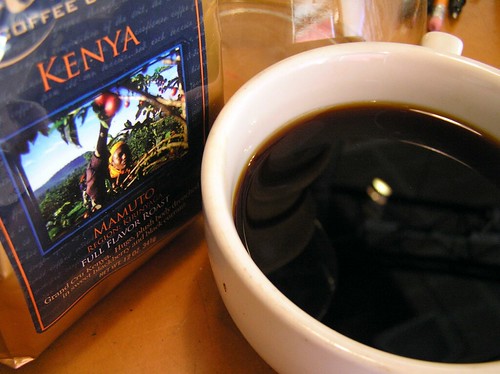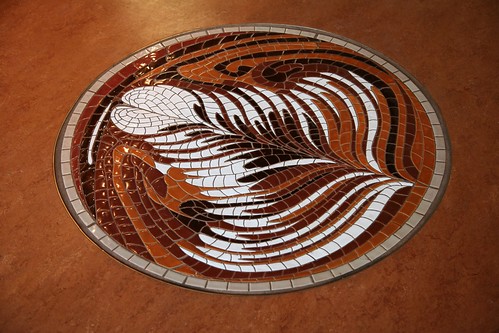Eliminating The SuspenseEsmeralda = emerald in Spanish, OK?
The Esmeralda That WasEsmeralda is one of the coffees widely regarded as one of the world's best; its reputation is that of a modern-day Jamaican Blue Mountain. Last year, my curiosity got the better of me and I arranged to procure some from
Paradise Roasters. In
blogging about it, I introduced it as follows:
I probably don't need to write too much about this one. If you have been living under a rock, or if you just happen to be one of the few people who doesn't follow the coffee auctions, you might not know that this is currently the world's most expensive coffee. Previously, that dubious honour went to kopi luwak. (I'll spare you the jokes - google it if it's news to you.)
Esmeralda has an impressive back story; in a nutshell, the gesha varietal that makes up the Esmeralda Especial lot seems to have basically gone extinct except for a few random rediscoveries in Panama. It just so happens that this particular farm's gesha offering has won something like four Best of Panama auctions and every single other cupping competition it has been entered in. In terms of scores, the consensus seems to be that it's a 92 at a minimum, with some tasters going as high as 97!
The 2007 Paradise Roasters lot displayed a predominant and intense mandarin flavour in all brewing methods, backed with hints of bergamot and a slight astringency.
The Esmeralda That IsLast year's, as far as I can tell, the correct name for it was "Hacienda Esmeralda Special." Flash forward a year and all of a sudden, the Petersons decided to shake things up by
sorting the crop into different lots, all of which were
auctioned under the "Hacienda Esmeralda Special" moniker. Again, the auction was blogged about widely. Readers are encouraged to post links to other relevant posts in the comments field. If you have to choose only one (other) blog post to read on the subject, remember the old saying - "in Hoff we trust." James' points about
dilution of their own trademark and the effect on the market struck a chord with me, particularly seeing as trade marks was one of my favourite subjects.
The auction itself always reads like a who's who, so you might like to imagine Joan Rivers delivering the commentary. Stumptown was wearing batch one, hailing from "north of the creek," but the heavy hitter
shared the most expensive batch, two, with Sweet Maria's. The dashing duo deftly devoured batch three, the peaberries, whilst 49th snapped up the sole double pass lot. Though the Petersons didn't credit Mountain Top for their technique - as I understand it - one wonders if the Piccolo clan's decision to purchase wasn't influenced by best buddy, Australian Mountaintopophile and coffee guru, Instaurator, who has done some consulting for them. Batches six through ten were bought by a wide spectrum. For the readers of this blog who I know follow the Japanese CoE buying circuit, it looks like crowd favourite
Kentaro Maruyama didn't even contest the Esmeralda auction against big dog
Wataru Nishibayashi. Presumably this means that Wataru will edge ahead of Maruyama in the awesome coffee purchasing league tables, but I would still want a several Watarus for my mint condition Maruyama trading card.
Competition results also deserve a mention. This year, the Petersons gave the
Best of Panama competition a miss, presumably in order to give someone else a chance at winning. They also failed to place first for the fourth time in a row at the SCAA cupping pavillion (perhaps one of my kind readers could provide the link; I can't seem to find it). Fortunately, though, they did at least manage to walk away with first place in the rain forest alliance
cupping for quality competition.
Anyhoo, that's enough background.
Having had spectacular success with the
Mamuto, I decided to place an order for Esmeralda with
Terroir, along with a few other goodies for various people:
 Nim's care package; two packs of Esmeralda, a pack of Mamuto, Coffee Trail book, Hacienda La Minita book and a pack of the AWESOME filtropa pourover filters to go with his filter cone.
Nim's care package; two packs of Esmeralda, a pack of Mamuto, Coffee Trail book, Hacienda La Minita book and a pack of the AWESOME filtropa pourover filters to go with his filter cone.Let's take a closer look at that label ...

Where's the trademark Howell photo?It was interesting to note that last year's batch from Paradise was comprised of unusually long and thin beans. This year's lot from Terroir looked considerably shorter and rounder ... perhaps a consequence of the decision to separate Esmeralda Special into different lots.
Anyhoo ...
Siphon/Vac Pot/Clover: These brews varied from being excellent to OK and I found the coffee difficult to work with. Several tasters agreed that there were Earl Grey tea (bergamot) notes, but differed to the intensity that they perceived. Sweetness was not as high as I had hoped, there was a good measure of acidity and the coffee was dry. The best brews had hints of peach.
Espresso: As I felt that the coffee was slightly too dark for siphon, I took it into the big V, borrowed one of their grinders and treated everyone to some Esmeralda espresso. The espresso had the kind of astringency that I usually associate with a roast that is slightly too light for espresso, but displayed a tiny amount of sweetness and some tannic tea type flavours.
This lot was interesting, but not the mind-blowing experience of last year's lot. Differences could have been due to (a) the separation of the Esmeralda Special lots this year, (b) the roasting of the coffee and (c) the shipping of this coffee, and attendant two week delay from roasting, compared with the last lot being brought over in carry on luggage. It would be very interesting to try out the various lots from the various sources that bought them, but that would probably end up being an expense to rival Krusty the clown's addiction to faberge' eggs.
The Esmeralda that will be ...?It will be interesting to see if anyone actually does the work of tasting all of the various Esmeralda lots and working out how big the spread in quality is. Who knows how Esmeralda Special will be divided up in future? I am also very interested to find out how 49th's lot will go and whether this processing method might take off in Panama.
Digression - Siphon - Again
Siphon continues to be a learning experience, though brews are usually pretty good nowadays. I thought that the butane burner warranted a quick post. Frankly, I can't see how you can really use a siphon without putting it on the stove or using a butane burner. I bought mine off ebay from Jack Grieve. A similar burner is available at a very reasonable price through
Jack's web store, along with some pretty cheap siphons.
When used in conjunction with a thermocouple, the butane burner makes it possible to get repeatable and adjustable brew temperatures. A marathon session of three siphon brews (and three cleaning runs) showed that the burner seems to emit more heat immediately after it is filled with gas. Good practice would be for the first use after refilling to be in a cleaning run.
So far, adjustments to the water temperature, dose and grind for the siphon have had eerily similar effects to doing the same thing for espresso.
One final tip - remember that every siphon brew is diluted by the water that doesn't make it into the top chamber to start off with and, as this is a fixed amount, the proportion of each brew that is made up of water that has never been in contact with coffee will increase if you try to brew less than the maximum amount for any given siphon. This lead to the experiment and realisation that if the brew is slightly on the strong side, dilution with hot water can sometimes save it.
Labels: Commercial Coffee, Drip, Gear, Single Origin, Syphon

















